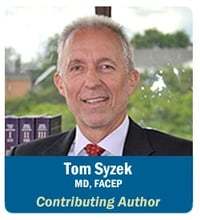 Pain management in the acute care setting (ED, Urgent Care, office) has once again catapulted to the top of the list of hot topics. Years ago the conversation centered on recognizing pain as a “fifth vital sign” and navigating the tricky crossroad of patient satisfaction and the provision of timely, sufficient pain medication. In the Emergency Department, I witnessed every extreme of practitioner and patient behavior.
Pain management in the acute care setting (ED, Urgent Care, office) has once again catapulted to the top of the list of hot topics. Years ago the conversation centered on recognizing pain as a “fifth vital sign” and navigating the tricky crossroad of patient satisfaction and the provision of timely, sufficient pain medication. In the Emergency Department, I witnessed every extreme of practitioner and patient behavior.
The Swinging Pendulum of Pain Management
At one end of the spectrum, an ED physician colleague routinely prescribed only ibuprofen unless the patient had an open long-bone fracture – no exceptions. In the same ED on the same day, another physician provided opioids early and often in an expedited attempt to avoid conflict and satisfy patients. The spectrum of patient behavior ranged from stoic statements such as, “I don’t want pain medication; I want to know what’s wrong,” to the confrontational, “If you are so uncaring and incompetent that you won’t give me my IV Dilaudid and Oxycontin prescription, I will march right over to the CEO’s office and complain!” I am paraphrasing this last remark rather than quoting the usual angry and threatening profanities.
Now the pendulum has swung hard in the opposite direction, away from opiates. No surprise that the problems of pill mills and opioid overprescribing have been exposed at the same time that opioid abuse and addiction have skyrocketed; and not just in the headlines, but in daily life in homes, streets and EDs filled with the ravages of opioid abuse, withdrawal, and heroin overdose deaths. Don’t ask me to apportion blame; it is already an overwhelming problem to fix without polarizing practitioners, patients, politicians and other players. Let’s spend our energies to quickly digest and learn from the past and move on. Recognize that pain - whether acute or chronic, psychological or physical - has and always will be with us as a challenging patient complaint. It is daunting to measure or verify pain, and it is often difficult to rapidly diagnose it in our suffering fellow humans who have varying degrees of addiction potential.
First Do No Harm
 The “right answer” to pain management in the acute care setting is neither simple nor easily found, especially when a practitioner is dedicated to relieving suffering and simultaneously to doing no long-term harm. Practitioners feel squeezed by pressures of peers, patient expectations, throughput times, incomplete information, and inadequate evidence on which to base decisions. It is difficult and confusing to professionals and patients alike when the pain management strategies vary wildly and inconsistently. On the other hand, rigid cookbook strategies may not allow for physician judgment in individual cases.
The “right answer” to pain management in the acute care setting is neither simple nor easily found, especially when a practitioner is dedicated to relieving suffering and simultaneously to doing no long-term harm. Practitioners feel squeezed by pressures of peers, patient expectations, throughput times, incomplete information, and inadequate evidence on which to base decisions. It is difficult and confusing to professionals and patients alike when the pain management strategies vary wildly and inconsistently. On the other hand, rigid cookbook strategies may not allow for physician judgment in individual cases.
A Good Starting Place
It seems obvious that a good place for practitioners to start is to use evidence-based approaches to manage pain. Alexis M. LaPietra, DO, is an emergency physician with fellowship training in emergency medicine pain management. Two of her initiatives serve as welcome advances in the area of pain management in acute care settings.
ALTO Program
First, Dr. LaPietra initiated a program at St. Joseph’s Regional Medical Center in Paterson, New Jersey, called Alternatives to Opiates (ALTO) with the goal to “help improve pain management, patient care, and patient safety.” The goal is not an opioid-free ED; opioids are still used appropriately, but they are not given automatically as first-line treatment. Some examples of the ALTO program include:
- Using targeted non-opioid medications – IV lidocaine for ureteral colic
- Trigger-point injections for low back pain
- Ultrasound-guided nerve blocks for extremity fractures
ACEP Pain Management Section
Second, Dr. LaPietra started the “Pain Management” section of the American College of Emergency Physicians (ACEP) to “…serve as a venue to discuss relevant pain management topics such as multimodal non-opiate analgesia as well as novel and evidence-based approaches for the management of chronic pain and opiate addiction.” The section will “…collaborate with the Ultrasound, Pediatrics, Geriatrics, and Palliative Care sections, as well as others in the College, to address controversial issues and help elevate pain management knowledge and practice.”
Dr. LaPietra notes, “In the current political climate, where opiates are a hot issue and compensation is directly related to patient satisfaction and pain relief, emergency physicians that are caught in a bind. We are torn between traditional pain management modalities, concerns about not feeding addiction, and the desire to relieve pain. We all treat pain every day, but we can do it better by incorporating new medications and modalities and applying them in innovative ways. Our patients and our specialty will benefit enormously from these advances in our practice.”
How can we argue with that? Utilize evidence-based approaches, improve patient care and safety, collaborate with others, incorporate new medications and modalities and apply them in innovative ways. This goes for all acute care settings and not just Emergency Medicine. Sounds like a great place to start.
Learn more for CME
All of these concepts are covered in extensive detail in our online course:
References
- http://www.acepnow.com/article/st-josephs-regional-medical-center-aims-avoid-opioid-use-emergency-department/
- http://www.acepnow.com/article/aceps-new-pain-management-section-provides-venue-discuss-pain-topics-opioid-addiction/


